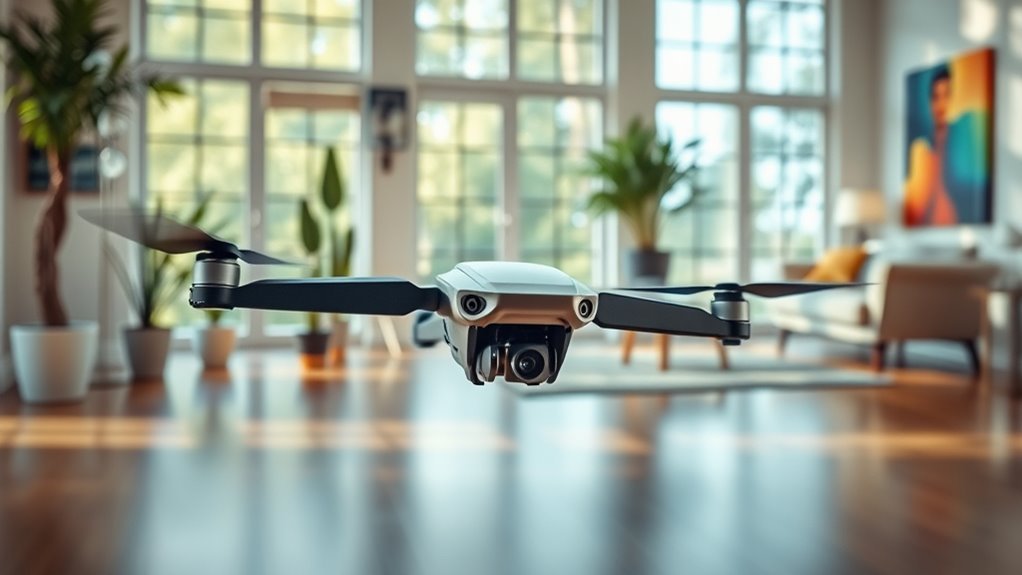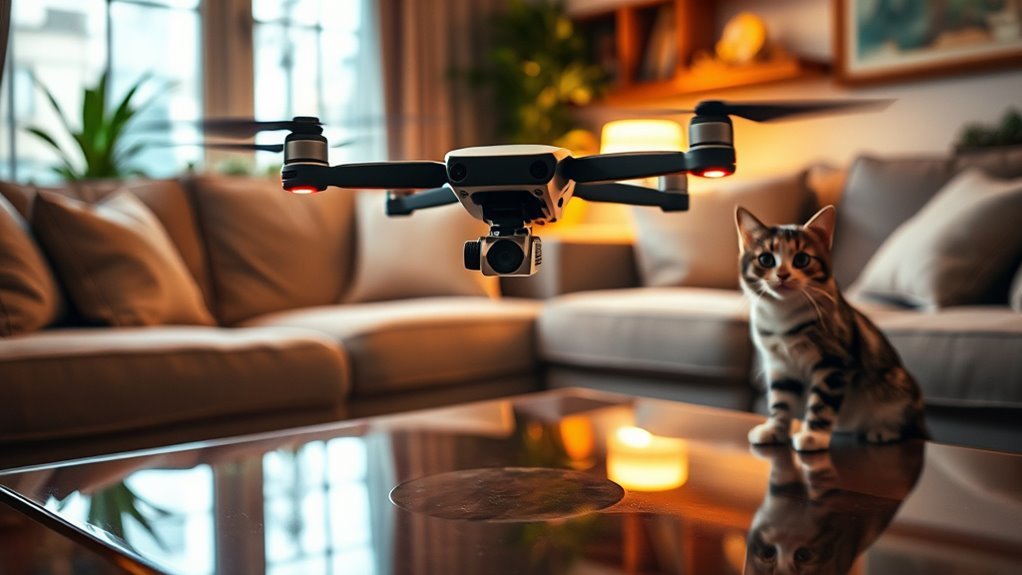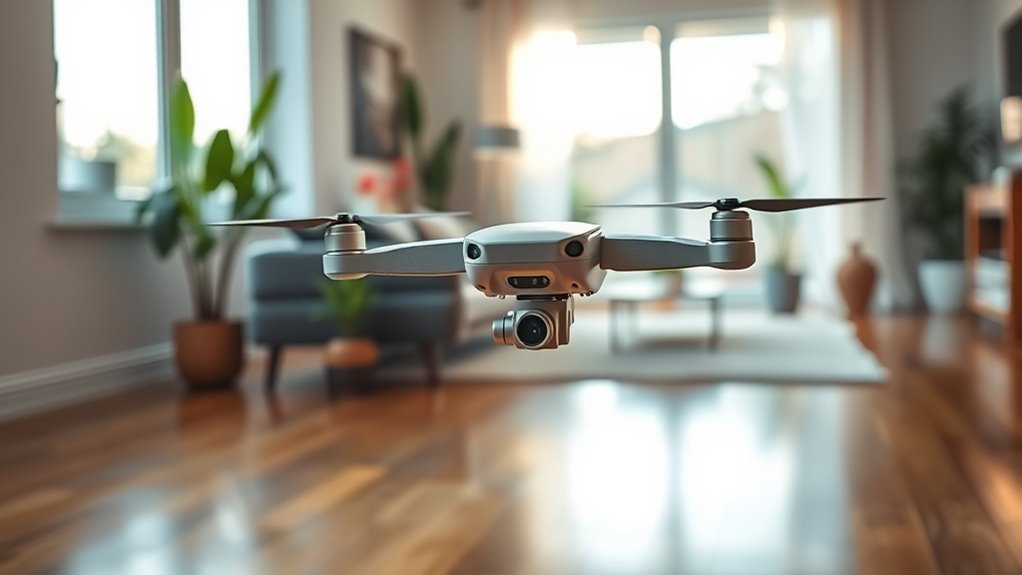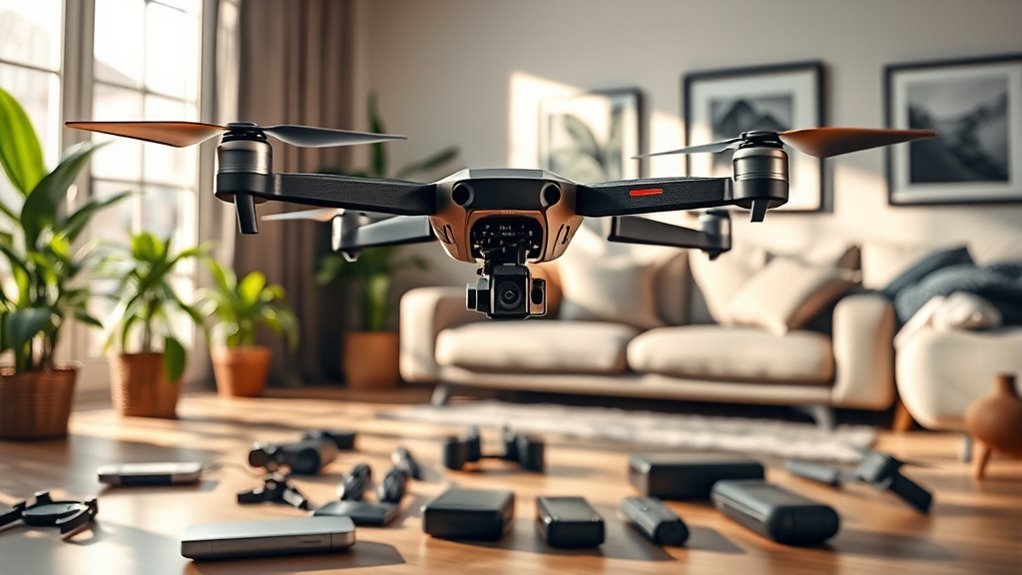If you’re looking for indoor drones, you’ll want models with precise controls, strong stabilization, and reliable obstacle avoidance to navigate tight spaces safely. Budget-friendly options like Holy Stone HS210 offer beginner-friendly features, while high-performance drones deliver speed and agility for enthusiasts. Compact units emphasize lightweight maneuverability, and some include cameras for aerial shots. Battery life usually lasts around 10–20 minutes, so plan accordingly. To understand which drone best fits your needs and flying style, keep exploring these key aspects.
Top Features to Look for in Indoor Drones

When choosing an indoor drone, it’s essential to focus on features that enhance maneuverability and safety within confined spaces. Advanced indoor drone technology often includes precise sensors and stabilization systems that allow you to navigate tight areas smoothly. Look for drones with obstacle avoidance to prevent collisions, ensuring your freedom to explore without constant worry. Compact size and lightweight design also contribute to better control and less risk of damage. Additionally, consider battery life and ease of maintenance; accessible components simplify drone maintenance tips, helping you keep your device in peak condition. Prioritizing these features lets you enjoy the full potential of indoor flying while maintaining safety and control in restricted environments.
Best Budget Indoor Drones for Beginners

Finding the right indoor drone on a budget can be challenging, especially if you’re new to flying. You’ll want to focus on affordable options that don’t sacrifice essential beginner friendly features. Here are three top choices to evaluate:
- Syma X20 – Compact and lightweight, it offers altitude hold and headless mode, making control easier for beginners.
- Holy Stone HS210 – Durable and stable, with one-key takeoff/landing and a flight time suitable for practice sessions.
- Eachine E010 – Features propeller guards and responsive controls, helping you avoid crashes while learning.
These drones balance cost with functionality, granting you the freedom to practice indoors without overwhelming complexity or high expenses.
High-Performance Indoor Drones for Enthusiasts

When choosing a high-performance indoor drone, you’ll want to prioritize speed and maneuverability to handle tight spaces with precision. Battery life and range also play vital roles, as longer flights allow for more extensive practice and exploration. Additionally, build quality and durability guarantee your drone can withstand the demands of advanced flying and occasional collisions.
Speed and Maneuverability
Although indoor drones are often associated with stability and ease of control, high-performance models designed for enthusiasts prioritize speed and maneuverability without compromising safety. When you evaluate these drones, consider the following:
- Agility Assessment: Look for drones with responsive controls and precise handling, enabling sharp turns and quick altitude changes essential for indoor navigation.
- Speed Comparison: Analyze top speeds in confined spaces, balancing rapid movement with obstacle avoidance technologies to maintain control.
- Maneuvering Features: Focus on drones equipped with advanced stabilization systems and customizable flight modes that enhance your ability to execute complex maneuvers effortlessly.
Battery Life and Range
How long can you expect your high-performance indoor drone to last before needing a recharge? Battery performance varies, but typical flight times range from 10 to 20 minutes. Since indoor spaces are confined, range limitations are less critical than outdoor drones. Still, understanding these constraints helps you plan uninterrupted flights.
| Drone Model | Battery Life (min) | Effective Indoor Range (m) |
|---|---|---|
| AeroX Pro | 18 | 50 |
| SwiftFly 3000 | 15 | 40 |
| NanoGlide V2 | 12 | 35 |
| Phantom Lite | 10 | 30 |
| Velocity X1 | 20 | 55 |
Choose drones with optimized battery performance to maximize your indoor flying experience and freedom.
Build Quality and Durability
Since indoor drones often navigate tight spaces and face frequent collisions, their build quality and durability become critical factors for enthusiasts seeking reliable performance. You need a drone that can withstand impacts without compromising agility or control. Here’s what to focus on:
- Design Materials: Opt for drones made with lightweight yet robust materials like carbon fiber or reinforced plastics to balance strength and maneuverability.
- Structural Integrity: Check for solid frame construction with reinforced joints to guarantee the drone maintains shape after repeated knocks.
- Protective Features: Look for integrated propeller guards and shock-absorbing components that minimize damage during crashes.
Compact and Lightweight Indoor Drone Options
When choosing a compact indoor drone, you’ll want to focus on mini models that offer precise control without sacrificing stability. Lightweight designs enhance maneuverability and reduce the risk of damage during collisions, making them ideal for tight spaces. Understanding the balance between size, battery life, and flight features will help you pick the best option for your indoor flying needs.
Best Mini Drones
Although indoor flying demands drones that are compact and lightweight, selecting the best mini drone requires careful consideration of factors like stability, battery life, and ease of control. With advances in mini drone technology, you can find models that balance these aspects effectively, ensuring smooth indoor navigation without sacrificing flight time. When choosing your mini drone, consider:
- Stability: Look for drones with built-in gyroscopes and altitude hold to maintain control in confined spaces.
- Battery Life: Prioritize models offering at least 10 minutes of continuous flight to maximize indoor exploration.
- Indoor Drone Accessories: Opt for drones compatible with protective guards and spare parts to enhance durability and performance.
Lightweight Flight Features
Building on the importance of stability and battery life in mini drones, the focus shifts to lightweight flight features that enhance indoor maneuverability. When choosing a compact drone, you’ll notice that the use of lightweight materials like carbon fiber or advanced plastics markedly reduces overall weight without compromising durability. This reduction allows for quicker, more responsive movements, essential in confined spaces. Additionally, advanced flight sensors play a pivotal role; they provide real-time data that helps maintain balance and precise control, even amid obstacles. These sensors, combined with lightweight construction, offer you the freedom to navigate tight indoor environments smoothly and confidently. Selecting a drone with these features guarantees optimized performance, giving you the agility and control needed for seamless indoor flight experiences.
Indoor Drones With Camera Capabilities
Since indoor drones with camera capabilities combine compact design with advanced imaging technology, they offer unique opportunities for both hobbyists and professionals. When choosing one, you’ll want to focus on:
- Camera Quality: Look for drones equipped with high-resolution sensors and adjustable lenses. This guarantees crisp images and smooth video, even in low indoor lighting.
- Drone Stability: Stability is essential for clear footage. Opt for models with gyro stabilization and responsive controls that minimize vibration and drift.
- Portability and Control: A lightweight, agile drone lets you navigate tight spaces freely, while intuitive controls provide precise maneuverability.
Safety Features in Indoor Drones
When you’re flying a drone indoors, safety features become critical to prevent damage and injury. You’ll want a drone equipped with reliable collision avoidance systems that use sensors to detect and steer clear of obstacles in tight spaces. This technology minimizes crashes, allowing you more freedom to explore without constant worry. Additionally, propeller guards are essential—they shield the blades and anything or anyone nearby from harm. These guards not only protect your drone’s hardware but also reduce the risk of injury or damage if it brushes against walls or furniture. Together, collision avoidance and propeller guards provide a balanced safety approach, enabling you to enjoy indoor flying confidently while safeguarding both your drone and your environment.
Battery Life and Charging Considerations
Understanding battery life and charging considerations is essential for maximizing your indoor drone experience. Efficient power management guarantees longer flight times and reduces downtime. Here are key points to focus on:
- Battery maintenance tips: Regularly calibrate your battery and avoid deep discharges to extend overall lifespan.
- Charging time optimization: Use the manufacturer-recommended charger and avoid overcharging to maintain battery health and readiness.
- Flight duration awareness: Recognize that indoor drones typically offer shorter flight times, so plan your sessions accordingly to prevent unexpected power loss.
Ease of Control and Flight Stability
When flying indoor drones, you’ll notice that handling precision directly affects your ability to navigate tight spaces smoothly. Consistent hovering is equally essential, as it guarantees stable shots and safer flights around obstacles. Evaluating these factors helps you determine which models offer reliable control and steady performance indoors.
Handling Precision
Although indoor drones vary widely in design, their handling precision directly affects how confidently you can navigate tight spaces and execute smooth maneuvers. To maximize control, understanding the role of drone calibration techniques is essential—they guarantee sensors provide accurate data, reducing drift and erratic responses. Flight control algorithms also play a critical role by processing sensor inputs to stabilize and adjust the drone in real time. When evaluating handling precision, consider:
- Responsiveness: How quickly and accurately the drone reacts to your inputs.
- Stability: The drone’s ability to maintain steady flight without excessive oscillation.
- Calibration Ease: The simplicity and frequency of required recalibration for peak control.
Mastering these aspects lets you enjoy fluid, precise flights indoors with minimal frustration.
Hovering Consistency
Because hovering consistency directly impacts ease of control and flight stability, it’s vital to assess how well a drone maintains a steady position without unwanted drift or oscillation. When you rely on advanced hovering technology, the drone actively compensates for minor air currents and sensor inaccuracies, keeping it stable mid-air. Effective altitude control plays an important role here, ensuring the drone holds a consistent height without constant manual adjustments. For indoor environments where space is limited, this precision grants you greater freedom to navigate tight spots confidently. You want a drone whose hovering consistency minimizes corrective inputs, allowing you to focus on your flight path rather than battling instability. Evaluating these aspects objectively helps you choose a drone that seamlessly supports smooth, controlled indoor flying experiences.
Popular Brands in the Indoor Drone Market
While the indoor drone market has expanded rapidly, a few key brands have established themselves as leaders through innovation and reliability. When evaluating drone specifications and brand comparisons, you’ll find these three stand out:
- DJI – Known for advanced stabilization and precise controls, DJI drones offer top-tier indoor flight performance. Their compact designs maximize freedom without sacrificing power.
- Parrot – Parrot models impress with lightweight frames and intuitive interfaces, perfect for maneuvering tight indoor spaces with agility.
- Holy Stone – Offering budget-friendly options, Holy Stone balances durability with essential features, making indoor flying accessible without limiting your freedom.
Understanding these brands helps you select a drone that matches your indoor flying preferences while ensuring consistent performance and reliability.
Tips for Flying Drones Safely Indoors
If you want to enjoy flying your indoor drone without causing damage or injury, you need to prioritize safety measures from the start. First, familiarize yourself with indoor flying techniques such as maintaining controlled speed and smooth, deliberate maneuvers to reduce the risk of sudden impacts. Utilize drone collision avoidance features when available, as they provide real-time obstacle detection and help prevent crashes against walls or furniture. Before flying, clear the area of fragile objects and guarantee adequate lighting for better visual orientation. Always keep your drone within line of sight and avoid crowded spaces where uncontrolled movement can lead to accidents. By combining these strategies, you’ll maximize freedom in flight while minimizing risks, creating a safer environment for both you and your drone.

